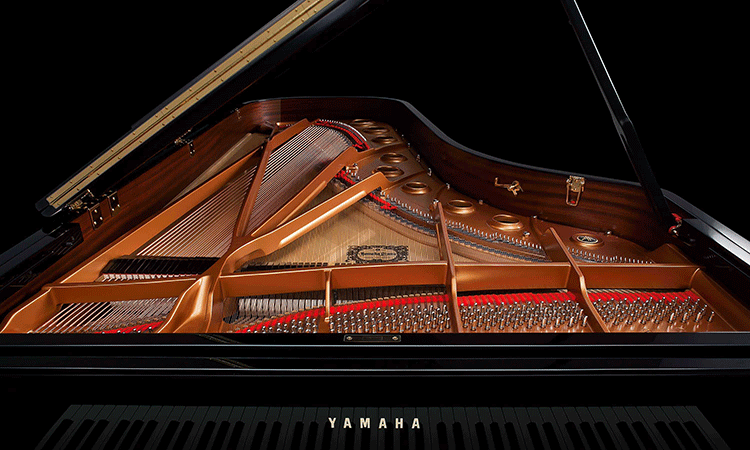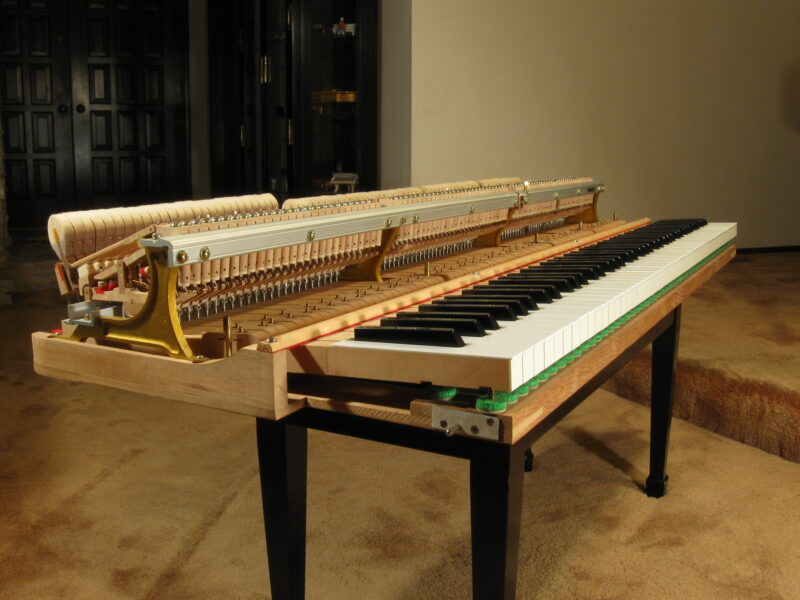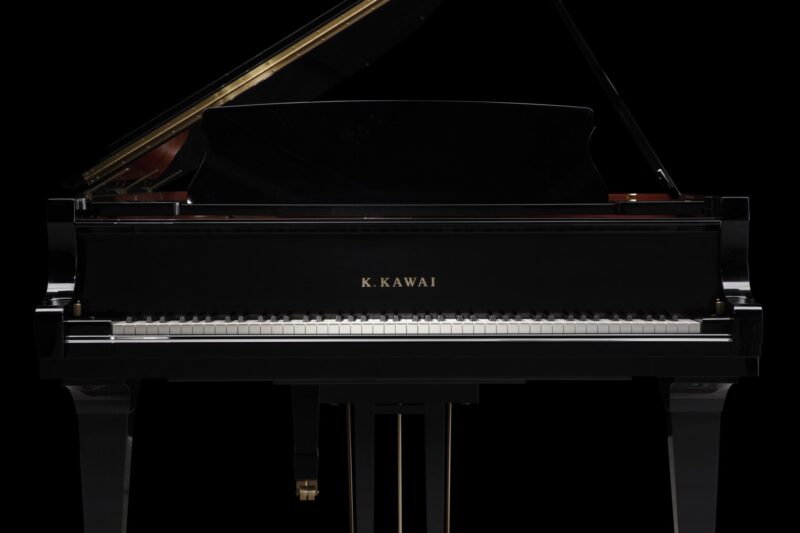When it comes to professional quality grand pianos approaching the 6-foot classic size marker, there’s no question that one of the world’s most popular comparisons is the Yamaha C2X vs Kawai GX2 Blak. Especially in North America, these two instruments are ubiquitous in post-secondary music institutions and other fine teaching studios.
In today’s article and companion video, we’re going to be comparing these two heavyweights. They’re very similarly priced, similarly sized, and two of the most often discussed and compared instruments in the industry.
Whether you’re shopping on behalf of an educational institution, a performance venue or simply looking to invest in a great piano for your home in the 6-foot range, you will undoubtedly come across these two great pianos.
Yamaha C2X Grand Piano
Let’s start with the Yamaha C2X.
This is a 5’8″ grand piano entirely built in Japan and is essentially an evolved version of the hugely successful Yamaha C2. In a lot of ways, the C2 evolved out of the more basic Yamaha G2, although they were technically considered two distinct product lines that were produced simultaneously for quite a number of years.
But there’s no denying that the C series definitely has an evolutionary root with the Yamaha G series, which was of course their first mainstream grand piano product that was brought into North America.
This means that a lot of people In North America grew up playing Yamaha G2s and G3s in schools, churches and in their homes. The C2X is the latest 5’8” professional-tier grand piano in this category.
Piano Sound

Yamaha’s traditional tonal profile is often widely described as ‘bright’, and in recent years we’ve been hearing the term ‘crispy’ used as well. There are a couple of key reasons why Yamaha’s have always had a brighter sound;
One reason has been the way in which they’ve manufactured their hammers in the past, the type of wool selected, and the method by which the wool is then packed. There are also scale design choices that contribute to a brighter tonal profile as well.
Due to higher scale tension, they also use slightly shorter strings than comparably sized pianos from other manufacturers. All of these factors help produce a clear, punchy attack which when joined with a harder hammer results in a bright and after a period of time, potentially metallic tone.
Modern Updates
In recent years, Yamaha has really tried to dial down the brightness. One of the things they’ve done to accomplish this is to really change their approach to the hammers. The hammers in the C2X are now a little bit thicker and the felt is not quite as dense. The result is a dialled-down attack and less potential for morphing into that metallic tone over time.
Secondly, they have also changed the steel piano wire used in the treble and midsection of the piano. And there’s no doubt that this has been a pretty successful endeavour as the tone is definitely more colorful than the Yamaha grands of the past, though it’s definitely still on the bright side of the tonal spectrum.
Clarity
Another feature of the C2X’s tonal profile is a great sense of clarity, especially throughout the mid-range of the piano. This clarity is a big reason why Yamaha’s are often selected as favorites for recording since this translates very well to a microphone, whereas certain features often preferred for live performance such as warmth and a greater sense of depth don’t necessarily lend themselves to recording.
Thickened Rim
Another upgrade Yamaha has made with the C2X is the inclusion of a thicker rim than what was featured in the C2. This has really improved the overall projection of the instrument even though the rim is still not as thick as the Kawai GX2’s rim.
The “Break” Area
Another thing we always take note of here at Merriam Pianos, especially when talking about pianos that are less than six feet in length, is how well they deal with the “break” area – the transition area of the piano between the steel strings and copper strings.
The C2X is not as smooth in this regard as some other instruments available in this price or size range. There’s a distinct difference in the tonal color when transitioning through this area.
Voicing can improve this to some extent, but not entirely, so this is something to be aware of.
Piano Action

Light Touch Curve
The C2X features an action entirely designed and manufactured by Yamaha that could be best described as having a light touch curve – a term used when describing digital piano action settings. What we mean here is that it doesn’t take very much effort to get this piano really firing with volume.
This gives the player the impression that the action is weighted lightly, but it’s actually weighted about the same as the Kawai GX2’s action – the difference is that the top end of the volume range comes much faster here.
Some players will love this, but at the same time, the downside is that you lose control in the lower dynamic ranges since there’s simply less real estate to work with down there.
Repetition Speed
Yamaha’s actions are known for their great repetition speed, and that sentiment certainly holds true here. This is a very quick action – even demanding classic repertoire is certainly manageable with this action.
Ivorite Keytops
The C2X’s white key tops are made of Yamaha’s proprietary Ivorite composite material which both looks and feels like natural ivory. It also has the same moisture-absorbing properties as ivory as well so this is a nice feature.
Yamaha C2X Wrap Up
All in all, what we’re looking at with the Yamaha C2X is a really well-built piano. The rim is slightly thicker than the previous C series, the treble strings are of higher quality, the tone is more colorful than Yamaha’s in the past if still bright, and the action is very fast while generating a ton of sound right away.
Kawai GX2 Grand Piano

The GX2 is the most commonly compared Kawai grand piano to the Yamaha C2X, but it’s actually 3 inches linger at 5’11”. Due to the different scale design, the longest bass string on the GX2 is actually even longer than three inches more than what you get on the C2X.
This factor alone guarantees that the GX2 is producing a very different tone from the C2X, especially in the bass register.
Like the C2X, the GX series is also made in Japan, and is also an evolved version of a previous Kawai piano, in this case, the Kawai RX2.
That said, the GX2 can be more accurately thought of as a production version of the handmade Shigeru Kawai SK2, featuring the same general design and many of the same components.
Design Similarities to the Yamaha C2X
The GX2 and the C2X have a number of design similarities. For one, both feature V-pro plates. This means that instead of the plates being sand-cast, they are cast using a more precise process. The GX2 also uses the double felted hammers, which Yamaha has switched to with the C2X, and this softens the attack and helps prevent the tone from becoming metallic.
Another similarity between these two instruments is they both use duplex scaling. As a result, the treble on both pianos is very nice and clear, though it’s slightly more complex on the GX2. Both pianos feature multi-laminated pinblocks, soft-fall fallboards and large music racks.
Beyond these things, the differences really start to emerge. We’ll start looking at those first as they pertain to the piano sound.
Piano Sound
The first thing that becomes really obvious when playing in the lower dynamic ranges is that the GX2 has a much more active cabinet and soundboard than the C2X. The GX2 uses a solid spruce tapered soundboard, while the C2X features an un-tapered soundboard – this is a key reason for the difference in cabinet and soundboard activation.
Tapered Solid Spruce Soundboard
Tapering refers to a process wherein a soundboard is precisely thinned out towards the edges of its circumference. This frees the soundboard up to resonate more lively, even at low dynamic levels. It also allows for better sustain and cabinet activation.
Tapering is fairly costly, though it is generally regarded as a best practice. The overwhelming majority of top-tier European hand-made pianos feature tapered soundboards, and even Yamaha’s upper-level SX and CF series grands feature tapered soundboards, so it’s not the case that we’re simply looking at differing philosophies in soundboard design here.
Konsei Katagi Rim
Kawai in general is known for their warm and oftentimes darker tone, and this is very apparent with the GX2, which also happens to be a very dynamic and colorful piano. Of course, the overall quality of the traditional craftsmanship is a factor here as is the presence of agraffes, Kawai’s unique Konsei Katagi rim is a big reason why as well.
The Konsei Katagi rim combines layers of different hardwoods to optimize and balance the tone. The inner rim features interlaminated small pore hardwoods for projection and large pore hardwoods for warmth, all equaling out to nothing short of superb tonal depth.
Action

Another huge difference between these two pianos is the feel, which of course primarily relates to the piano’s actions.
These two instruments feel very different from one another, and if you have some experience playing piano, odds are you’ll have a preference as to which one you prefer. In fact, even beginners will probably feel a pretty big difference here.
Where the C2X gets loud quite quickly, the GX2 takes requires more effort to get firing, which creates the perception that it’s a heavier action. Like we said above, they’re actually fairly evenly weighted, but the extra level of control the GX2 is easily mistaken for heaviness.
Extended Length Key-Sticks
The Kawai GX2 features keysticks that have been extended beyond the normal length for a 6-foot piano. They aren’t quite concert-length, but they’re about an inch and a quarter longer than the keys on the C2X and what were previously on the Kawai RX2.
The difference to the player is that you’re getting to work with a longer lever which is going to deliver more power, torque and touch control in the extreme dynamic ranges – both soft and loud.
Concert grands are the most dynamic type of grand piano, and the considerably longer key sticks are a critical reason why.
Millennium III Action
Beyond the key-stick length, the action design and componentry are also very different between these two grand pianos.
The C2X features a fairly traditional wood-based action. Conversely, the GX2 features the ABS-Carbon Fiber reinforced Millennium III action – the same action featured in the premium handcrafted Shigeru series of grand pianos.
Kawai has been experimenting with eschewing wood for composite action parts for decades, and there are a number of reasons for this. For one, carbon fiber-reinforced parts simply don’t shrink and expand with temperature and humidity changes.
This means that from a maintenance standpoint, this action is going to be more stable over a longer period of time and provide an overall more consistent touch than a similarly priced wooden action.
This action is also known for its lightning-fast repetition and keystroke speed – this is a big reason why the Shigeru Kawai SK-EX concert grand has become an increasingly popular choice with top-level concert pianists, converting even previously die-hard Steinway enthusiasts.
Neotex Key Surfaces
Like the C2X, the GX2’s action also features synthetic key textures on both the white and black keys made to imitate the touch, feel and absorptive qualities of real ivory. In Kawai’s case, they refer to this texture as Neotex.
Keybed
The GX2 also has a deeper, steel-reinforced keybed which allows the player to dig in a little bit further and take advantage of those extended-length keysticks. The keyslip is also steel reinforced.
Kawai GX-2 Wrap Up
The Kawai GX2 is also a very well-built piano. In comparison to the C2X, you’re getting a warmer, darker sound here that is also more colorful.
The Millennium III action also has some inherent mechanical advantages over the C2X’s action, but a preference will really come down to whether you want the more immediate power of the C2X, or more control that the GX2 offers.
Yamaha C2X vs Kawai GX2 – Closing Thoughts
This pretty much sums up the major musical differences between these instruments. In terms of quality of build, it’s pretty much dead even here – these are both extremely well-built instruments, and that’s the reputation both of these companies have for their grand and upright pianos.
We’ve laid out the particular nuances of each piano, so selecting one is going to come down to determining the best musical companion for you or your institution based on your needs.
The Kawai GX-2 certainly has a broader pallet that lends itself to classical music and certain inherent maintenance-related advantages due to the action, but on the other hand, the Yamaha C2X is going to lend itself better to recording and might be a better piano for pop music.
Thanks very much for reading, and be sure to check out the video!

